DigitalStorm Bolt Gaming System Review: It's Little But It's Fierce
by Dustin Sklavos on October 24, 2012 1:54 AM EST- Posted in
- DigitalStorm
- Systems
- Mini ITX
- Ivy Bridge
- Kepler
System Performance
I think when you look at a system like the DigitalStorm Bolt, it begins to sink in just how much power you can really cram into a tiny space. The Intel Core i5-3570K may not enjoy Hyper-Threading, but in every other way it's essentially one of the best gaming CPUs you can buy today and an absolutely killer value for enthusiasts. That said, DigitalStorm may have missed the boat a little bit by opting for an SSD caching solution instead of a dedicated SSD. We'll see in the benchmarks.

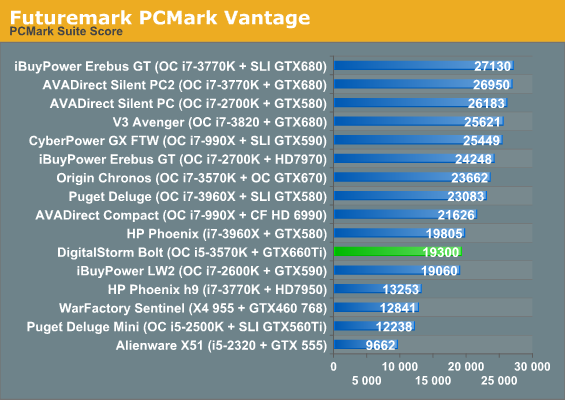
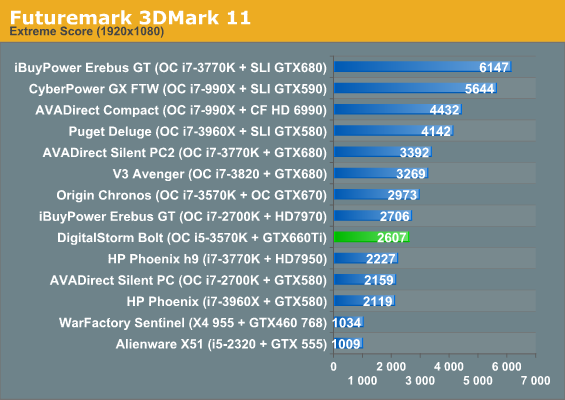
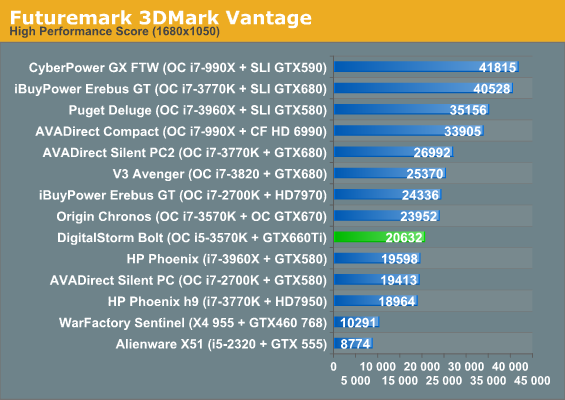
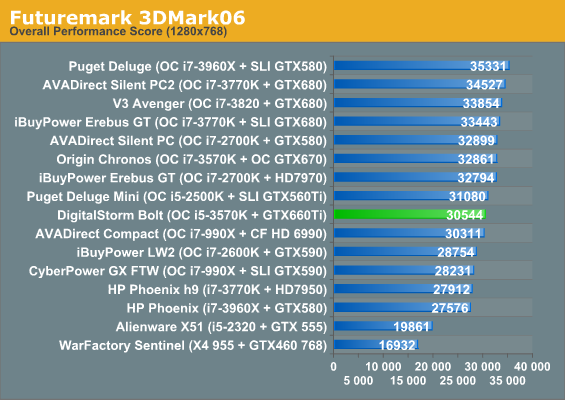
The Futuremarks are mostly kind to the Bolt, but it's clear there could've been a bit more oomph. DigitalStorm's shop page for the Bolt ranks the i5-3570K in this Level 3 configuration as being just as good for multitasking and general performance as the i7-3770K in the Level 4, but that's clearly not the case. In our charts, the i7-3770K is able to produce a very healthy lead during overclocking. You'll see that for gaming Hyper-Threading is basically pointless, but for media tasks the extra four logical threads can make a real difference.
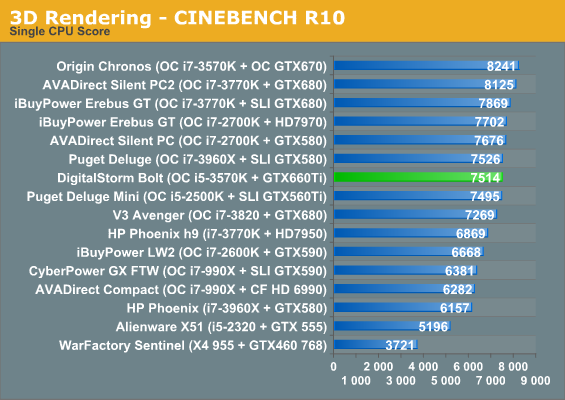
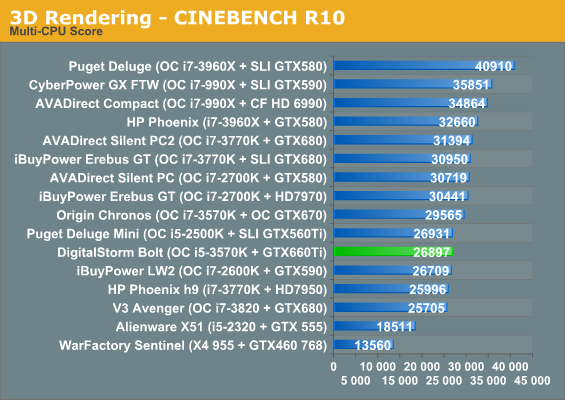
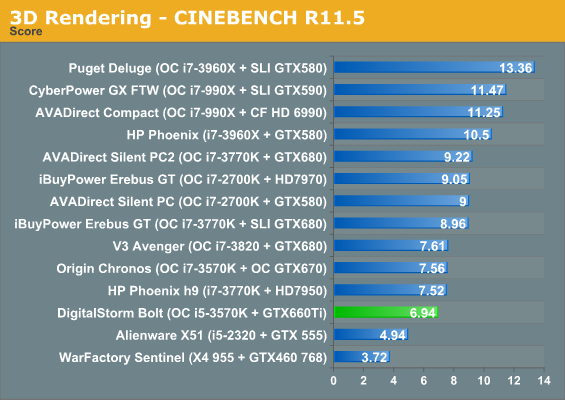
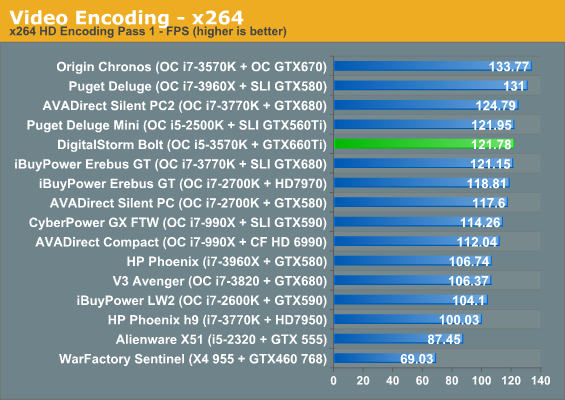
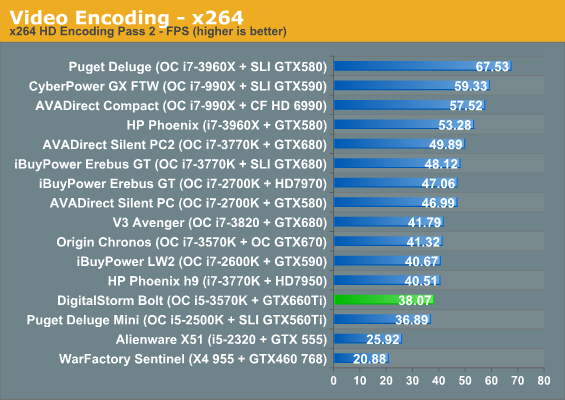
Scores on the CPU-centric tests fare about as well. The i5-3570K in the Bolt is hampered both by the lack of Hyper-Threading and by its more modest overclock. However, I'm extremely keen to point out that the overclock on the i5-3570K is also both more manageable and more efficient; many of these other systems are using much more elaborate cooling and oftentimes push core voltages well beyond where I'd be comfortable with them. Performance of the i5-3570K is plenty by most measures, and you'd need not just Hyper-Threading but more cores and/or a potentially unrealistic overclock to get a substantial jump on it.










19 Comments
View All Comments
just4U - Wednesday, October 24, 2012 - link
Stand up systems like these could really benifit from a slot loading DVD. Don't know why you don't see them around any more. I really liked my pioneer ones from back in the day.Dustin Sklavos - Wednesday, October 24, 2012 - link
I personally love slot-loading drives. The uh...the Alienware X51 has one.CaptainDoug - Wednesday, October 24, 2012 - link
So does the falcon northwest tiki.ImSpartacus - Wednesday, October 24, 2012 - link
Speaking of the X51, when will we see a review of the new IvB/660 version?I love the Bolt review, but I agree that the X51 might be a better value for those of us that only want a midrange system. I can't wait to see it in your lab.
Menty - Wednesday, October 24, 2012 - link
Probably just the price difference between tray and slot-load. For some reason, everytime I try to find a slot-load, it winds up being twice as expensive as a tray-load :(.MadMan007 - Wednesday, October 24, 2012 - link
Do you have actual noise measurements and forgot to put the chart in the article?Dustin Sklavos - Wednesday, October 24, 2012 - link
I tend to just measure systems individually and only point out noise when it's a serious issue.ursulache - Wednesday, October 24, 2012 - link
Hi,under what load was the power consumption measured?
Thank you.
landerf - Wednesday, October 24, 2012 - link
Not sure how I feel about a sleeve bearing fan on something as critical as the cpu... especially a scythe. Every slip stream me an my friend ever had leaked oil and seized up.nevertell - Wednesday, October 24, 2012 - link
I believe that if they had gone with a closed watercooling loop for both the gpu and cpu, it would make it even better. It's the small form factors that would actually benefit from wc at the time when cpu's sip power and kepler is the most efficient gaming architecture ever built by nvidia. Of course, then it wouldn't be as narrow, but the temperatures would be low even if they used just a 240mm long radiator. This would save space, since both of the major coolers are pretty big. If they wanted to make it even quieter, they could opt for a watercooled PSU.